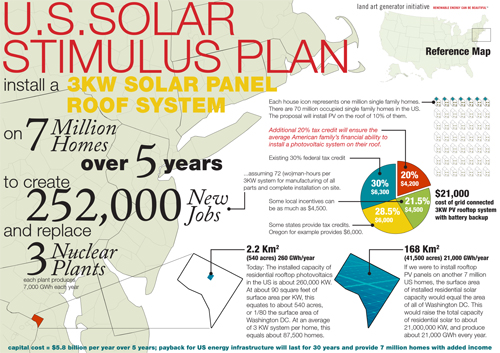
click on the image above for larger version
With the debate this week in the wake of President Barack Obama’s $447 billion Jobs Act proposal, we would like to offer one more modest suggestion that we thing will have a lasting positive impact on the economy, jobs, the environment, and will serve to lift up the spirit of America, setting a new standard of global leadership.
A 3KW photovoltaic system on each of 7 million US homes would require the manufacture and installation of enough solar panels to cover all of Washington DC. This ambitious project will create 250,000 jobs with staying power—supported by the lasting framework that the proposal will put in place for the continued growth of America’s renewable energy economy. With recent news to the effect that “green jobs” initiatives have been unsuccessful, it is about time that we get truly serious about turning that situation around.
This plan will increase the residential solar capacity of the United States by 8,000%, from 260MW to 21,000MW, by providing the perfect incentive that will lead to 10% of US single family homes to install 3KW (on average) grid-connected solar panel arrays on their rooftops with battery backup.
One 3KW grid-connected PV roof installation with battery backup runs about $21,000. The 3KW system takes up 258 square feet of roof area and will provide the home with between 2,250KWh and 3,500KWh per year depending on local conditions. That’s about 25% of an average family’s energy use (a much higher percentage for an energy efficient home).
As a result of these 7 million homes installing on-site solar power, the US energy grid will be relieved of the MWh power equivalent of three AP1000 type nuclear power plants every year. Or in another comparison, these solar homes will provide the power equivalent of burning nearly all of the coal that is extracted each year from mountaintop removal (MTR) mines in West Virginia.
The great symbolism of this 7 million home number lies in the fact that the surface area of photovoltaic that 7 million solar homes would create is approximately equal to the surface area of Washington DC (41,500 acres). While that is certainly a large area, and an accomplishment that we could all feel very proud about reaching, if you break it down by county, it comes to just 13.2 acres of photovoltaic panels per county (there are 3,141 counties in the USA).
The added incentive works like this: the US government already provides a tax rebate on the purchase of solar panels up to 30% of the cost. We suggest upping this to 50%. With this additional incentive, and factoring the existing rebates that currently exist at the state and local levels, the cost of a 3KW system will go down to between $8,700 to—in some cases—$0 (depending on other incentive programs in place at state and local levels). The existing 30% federal tax credit = $6,300; state tax credit: as much as 28.5% or $6,000 (Oregon model); other local incentives: up to 21.5% or $4,500; leaves 20% or $4,200 remaining—it’s this remaining amount that should be added to the federal level credit).
In this way, the payback period for the system (how long it takes the homeowner to pay for the installation from the savings in electricity bills) will be either immediate, or come down to no more than five years, after which the homeowner is simply earning money and the US electrical grid could decommission three nuclear power plants.
The additional price tag for this incentive offer (should 7 million homes decide to install solar panels over five years) will amount to $5.8 billion per year (7 million homes x $21,000 per installation = $147 billion x 20% additional federal tax credit = $29.4 billion / 5 years = $5.8 billion). This is a very small price to pay for such an amazing step towards sustainable energy security!
There is a lot of discussion about the fact that this new stimulus proposal is light on infrastructure. From infrastructurist.com:
• $50 billion for new infrastructure projects, including updating aging roads, bridges, rails and runways
• $10 billion for the creation of a National Infrastructure Bank that’s based on the expansion of the TIGER program
• $15 billion to rehab vacant and foreclosed homes/businesses
• Some undisclosed sum for getting high speed wireless to “98% of American”
• $25 billion to rehab schoolsIt’s a good start, to be sure. But is it enough? Ed Rendell, former Pennsylvania Governor and co-founder of Building America’s Future (and Infrastructurist contributor), was pretty clear in his opinions during yesterdays 9/11 Tenth Anniversary Summit at the Newseum in D.C. “It’s not big enough,” he said to a packed house during a panel on American resilience and rebuilding. According to Rendell’s and BAF’s estimates, each $1 billion invested in infrastructure produces 25,000 “well-paid” jobs on construction sites and in factories.
This newly expanded program for residential photovoltaic incentives will put the United States firmly in the lead for domestic solar production and the market stimulus will push innovation of the solar industry like nothing ever has before. It can be conceived of as a new Apollo mission for energy independence.
Related Posts
2 Comments
Add comment Cancel reply
This site uses Akismet to reduce spam. Learn how your comment data is processed.


[…] a decade ago, we wrote a piece called “SOLAR JOBS STIMULUS: 7 MILLION HOMES GET PV PANEL ROOFTOPS (COVER WASHINGTON D.C. WITH SOLAR PV!)” advocating for an expansion of incentives for residential rooftop solar […]
[…] our blog post on how to create even more incentive by raising the national tax credit to […]